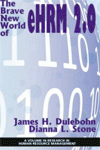
The Brave New World of eHRM 2.0
Edited by:
James H. Dulebohn, Michigan State University
Dianna L. Stone, Universities of New Mexico, Albany, and Virginia Tech
A volume in the series: Research in Human Resource Management. Editor(s): Dianna L. Stone, Universities of New Mexico, Albany, and Virginia Tech. James H. Dulebohn, Michigan State University. Brian Murray, University of Dallas. Kimberly M. Lukaszewski, Wright State University.
Published 2018
Information technology has had a profound effect on almost every aspect of our lives including the way we purchase products, communicate with others, receive health care services, and deliver education and training. It has also had a major impact on human resource management (HR) processes, and it has transformed the way that we recruit, select, motivate, and retain employees (Gueutal & Stone, 2005; Kavanagh, Thite, & Johnson, 2015). For example, some estimates indicated that 100 % of large organizations now use web-based recruiting (Sierra-Cedar, 2016-2017), and over half of the training conducted in America is delivered using technology-based methods (American Society for Training and Development, 2015). Results of a survey by the Society for Human Resource Management (SHRM) (2002) revealed that technology is one of the major drivers of change in today’s HR departments.
In spite of the increased use of technology in the field of HR, relatively little research has examined the acceptance and effectiveness of electronic human resource management (eHRM) methods. As a consequence, practitioners are implementing these new systems without the benefit of research. Thus, the primary purpose of this issue is to review the results of research on a number of important eHRM practices including e-recruitment, e-selection, gamification, e- socialization, e-learning, and e-performance management. It also considers how technology can be used to manage task-based contingent workers, and examines the problems associated with cyberdeviance in organizations. The chapters in this series should be extremely beneficial for HR researchers and practitioners who are employing these new systems.
CONTENTS
The Transformation of Human Resources Management through Technology and e-HRM, James H. Dulebohn and Dianna L. Stone. “Pounding the Pavement” in the 21st Century: A Review of the Literature Regarding Organizational Recruitment Websites, Sara A. Murphy, Peter A. Fisher, Lisa M. Keeping, and Douglas J. Brown. E-Selection: The History and Future of Technology in Employment Selection, David N. Dickter and Victor Jockin. Hiring for the Win: Game-Based Assessment in Employee Selection, Sarena Bhatia and Ann Marie Ryan. E-socialization: The Problems and the Promise of Socializing Newcomers in the Digital Age, Jamie A. Gruman and Alan M. Saks. A Review of Design Considerations in e-Learning, Richard D. Johnson and Jason G. Randall. Electronic Performance Management: Does Altering the Process Improve the Outcome? Stephanie C. Payne, Anjelica M. Mendoza, and Margaret T. Horner. Using eHRM to Manage Workers in the Platform Economy, Elizabeth A. Cassady, Sandra L. Fisher, and Shawnee Olsen. Unpacking the “e” of e-HRM: A Review and Reflection on Assumptions about Technology in e-HRM Research, Markus Ellmer and Astrid Reichel. An Examination of Workplace Cyberdeviance, Amber N. Schroeder and Julia H. Whitaker.
-
Paperback9781641131551
Web price: $45.04 (Reg. 52.99)
-
Hardcover9781641131568
Web price: $80.74 (Reg. 94.99)
- eBook9781641131575

- BUS030000 - BUSINESS & ECONOMICS: Human Resources & Personnel Management
- BUS066000 - BUSINESS & ECONOMICS: Training
- BUS000000 - BUSINESS & ECONOMICS: General
-
 Diversity and Inclusion in Organizations
Diversity and Inclusion in Organizations
-
 Forgotten Minorities in Organizations
Forgotten Minorities in Organizations
-
 Leadership
Leaders, Followers, and Context
Leadership
Leaders, Followers, and Context
-
 Managing Team Centricity in Modern Organizations
Managing Team Centricity in Modern Organizations
-
 Research Methods in Human Resource Management
Toward Valid Research-Based Inferences
Research Methods in Human Resource Management
Toward Valid Research-Based Inferences
-
 The Only Constant in HRM Today is Change
The Only Constant in HRM Today is Change
-
 The Plight of Stigmatized Groups in Organizations
The Plight of Stigmatized Groups in Organizations

